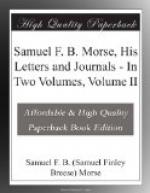“These fifteen thus chosen shall elect not less than ten, nor more than fifteen, professional artists, in or out of the association, who shall (with the previously elected fifteen) constitute the body to be called the National Academy of the Arts of Design. To these shall be delegated the power to regulate its entire concerns, choose its members, select its students, etc.
“Thus will the germ be formed to grow up into an institution which we trust will be put on such principles as to encourage—not to depress—the arts. When this is done our body will no longer be the Drawing Association, but the National Academy of the Arts of Design, still including all the present association, but in different capacities.
“One word as to the name ‘National Academy of the Arts of Design.’ Any less name than ‘National’ would be taking one below the American Academy, and therefore is not desirable. If we were simply the ’Associated Artists,’ their name would swallow us up; therefore ‘National’ seems a proper one as to the arts of design. These are painting, sculpture, architecture, and engraving, while the fine arts include poetry, music, landscape gardening, and the histrionic arts. Our name, therefore, expresses the entire character of our institution and that only.”
From this we see that Morse’s enthusiasm was tempered with tact and common sense. His proposals were received with unanimous approval, and on the 15th of January, 1826, the following fifteen were chosen:—S.F.B. Morse, Henry Inman, A.B. Durand, John Frazee, William Wall, Charles C. Ingham, William Dunlap, Peter Maverick, Ithiel Town, Thomas S. Cummings, Edward Potter, Charles C. Wright, Mosely J. Danforth, Hugh Reinagle, Gerlando Marsiglia. These fifteen professional artists added by ballot to their number the following fifteen:—Samuel Waldo, William Jewett, John W. Paradise, Frederick S. Agate, Rembrandt Peale, James Coyle, Nathaniel Rogers, J. Parisen, William Main, John Evers, Martin E. Thompson, Thomas Cole, John Vanderlyn (who declined), Alexander Anderson, D.W. Wilson.
Thus was organized the National Academy of Design. Morse was elected its first president and was annually reelected to that office until the year 1845, when, the telegraph having now become an assured success, he felt that he could not devote the necessary time and thought to the interests of the Academy, and he insisted on retiring.
In the year 1861 he was prevailed upon by Thomas S. Cummings, one of the original academicians, but now a general, to become again the president, and he served in that office for a year. The General, in a letter to Mr. Prime in 1873, says, “and, I may add, was beloved by all.”
I shall not attempt to give a detailed account of the early struggles of the Academy, closely interwoven though they be with Morse’s life. Those who may be interested in the matter will find them all detailed in General Cummings’ “Records of the National Academy of Design.”




